It is not uncommon to come across an orange spider. Often the orange coloration is confused with brown, making orange a common color in spiders.
Have you seen an orange spider in your home or yard and are wondering what it was? Continue reading below for information on the most common orange spiders in the United States.
Table of Contents
Common Orange Spiders
The 29 common orange spiders in the United States include:
1. Marbled Orbweaver
Scientific name: Araneus marmoreus.
Common name: marbled orbweaver, pumpkin spider.
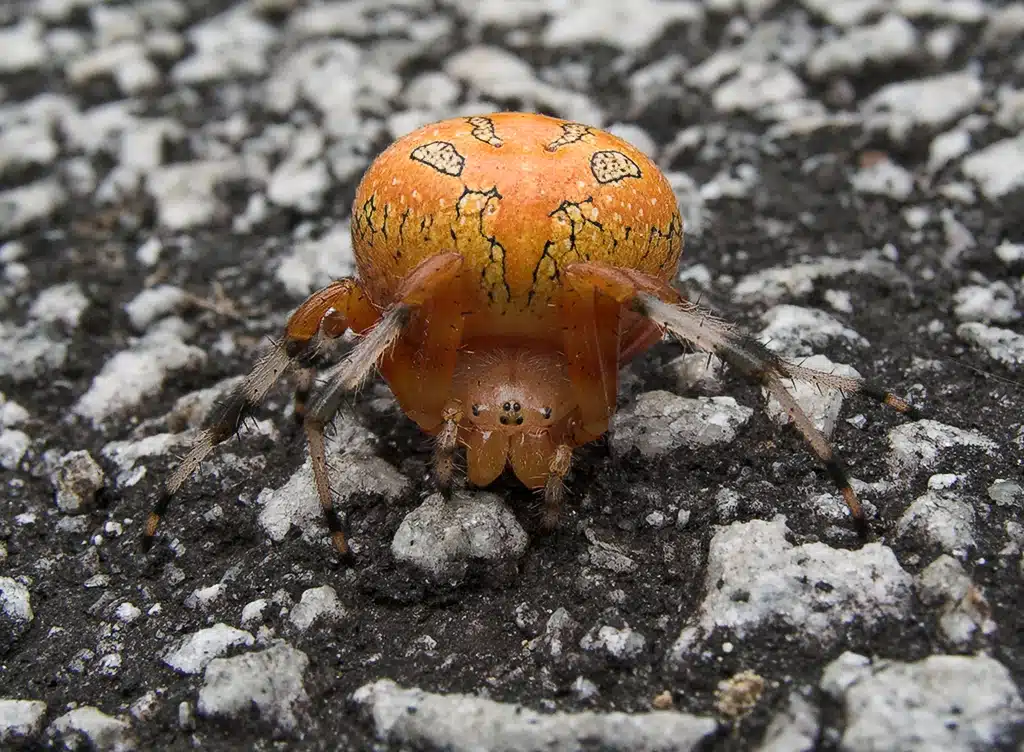
The marbled orb weaver has a unique marbled pattern of colors on its abdomen. The orange head and upper legs, along with black and white banding on the lower legs, make this an attractive spider.
Some of the marbled orb weavers have an orange and yellow abdomen, some black and orange. They create circular webs in wooded areas, never too far from water. Females, which are larger than the males, tend to stay in their retreats.
The female lays orange eggs, which are attached in a silken sac on the retreat, where she will guard them. Even though they can grow to a large size, they are not aggressive towards humans.
2. European Garden Spider
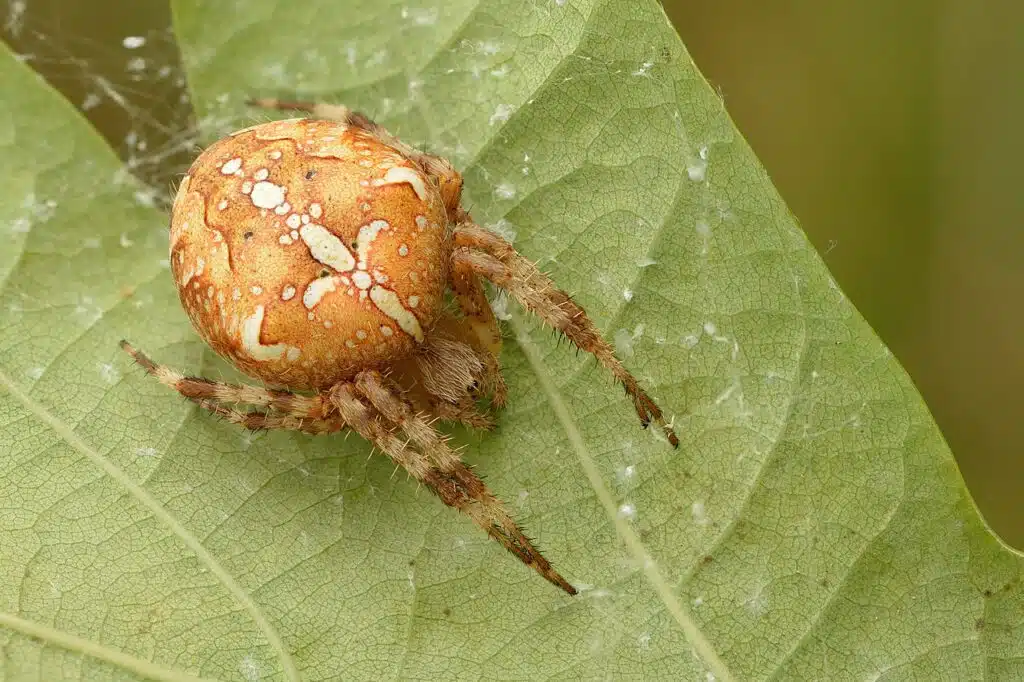
Scientific name: Araneus diadematus.
Common name: European garden spider, diadem spider, orangie, cross spider, crowned orb weaver, pumpkin spider.
The European garden spider is also known as the orange cross spider or pumpkin spider. This spider is native to Europe and has been introduced to North America.
Females grow to 20mm in body length, while the males are smaller, growing to around 13mm in body length. Their colors range from a pale yellow/brown to almost black, many look orange.
There are mottled white markings on the abdomen and four or more segments that form a cross.
3. Woodlouse Spider
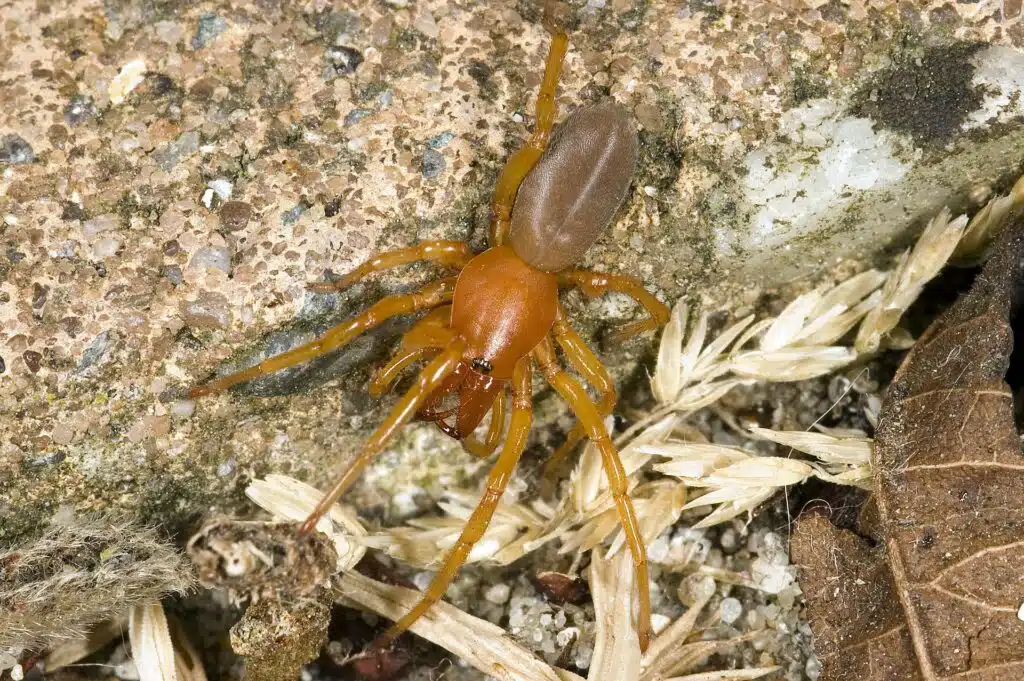
Scientific name: Dysdera crocata.
Common name: woodlouse hunter, sowbug hunter, sowbug killer, pillbug hunter, slater spider.
Woodlouse spiders feed o woodlice, with females growing to 15mm and males to 10mm in body length. They have an orange to red-colored cephalothorax and legs with a pale beige to yellow/brown abdomen.
This species is from the Mediterranean, introduced to North and South America, it is also very seldom found near human settlements.
4. Brown Widow
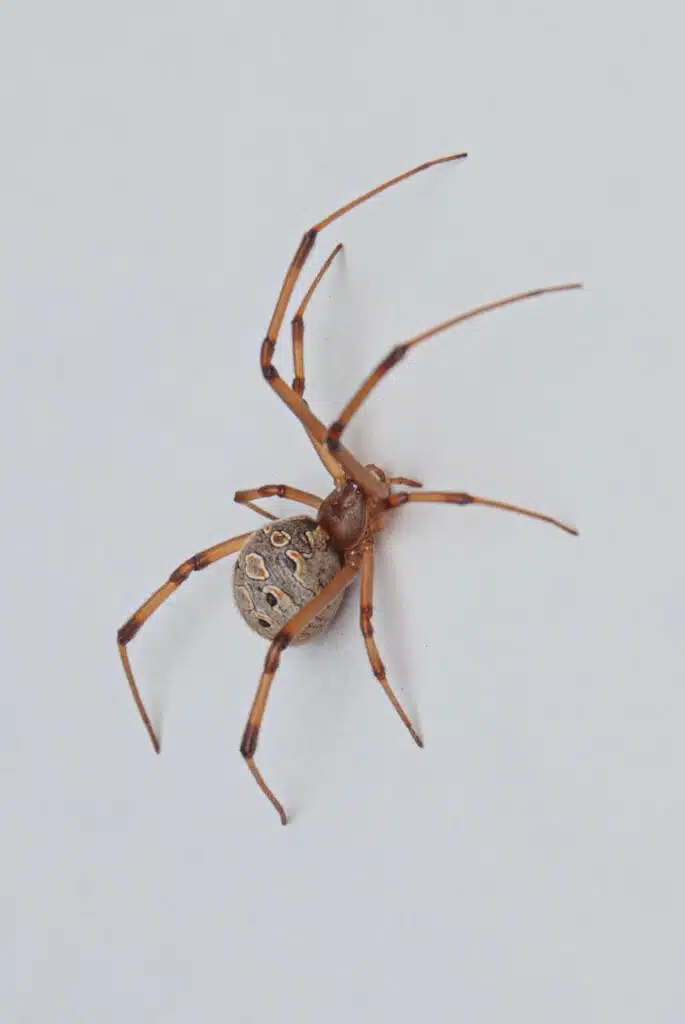
Scientific name: Latrodectus geometricus.
Common name: brown widow, brown button spider, grey widow, brown black widow, house button spider, geometric button spider.
The brown widow or brown button spider is a widow spider with black and white patterning on the sides and an orange to yellow hourglass shape on the belly. They are believed to have originated in South America.
They are usually found close to buildings in tropical areas in the United States, including Hawaii. Their venom is neurotoxic, but they are not as dangerous as the black widow. Bites are confined to the bite area and surrounding tissues.
5. Shamrock Orbweaver
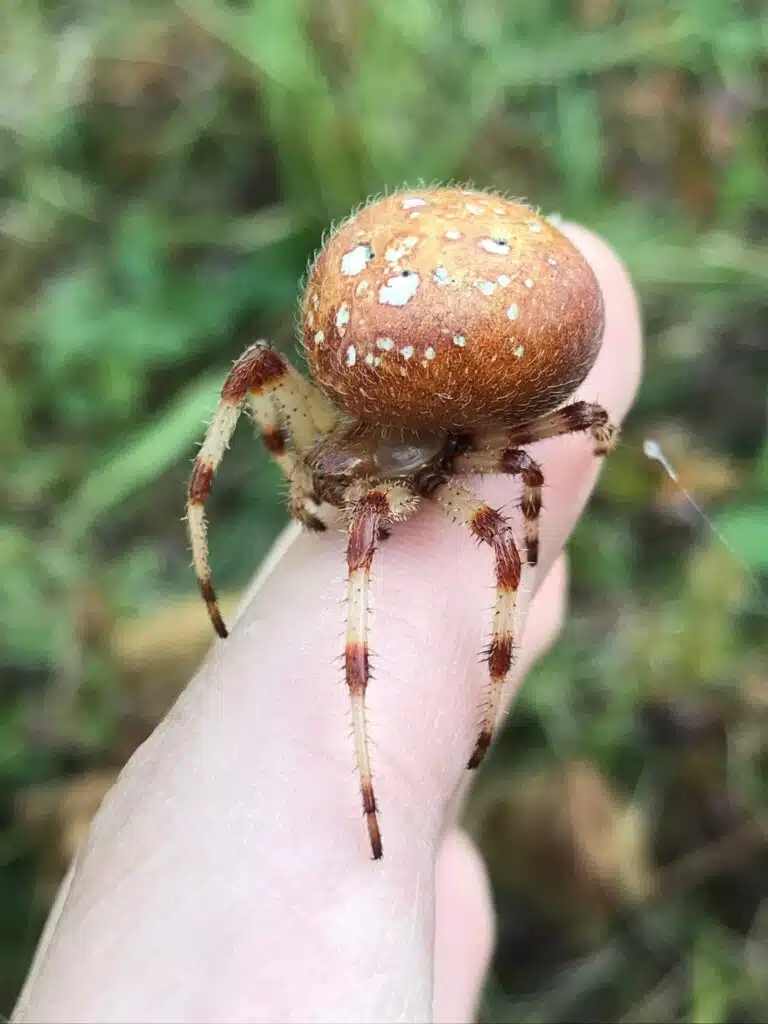
Scientific name: Araneus trifolium.
Common name: Shamrock orb weaver.
Shamrock orb weavers can be found throughout the United States. They vary in color from brown or beige, though some are orange or yellow. They are sometimes confused with the marbled orb weaver.
The shamrock orb weaver. has white dots on the back, which helps identify it. Their bites are painful but are not considered dangerous to humans. Their bite is no worse than a bee sting.
6. Striped Lynx Spider
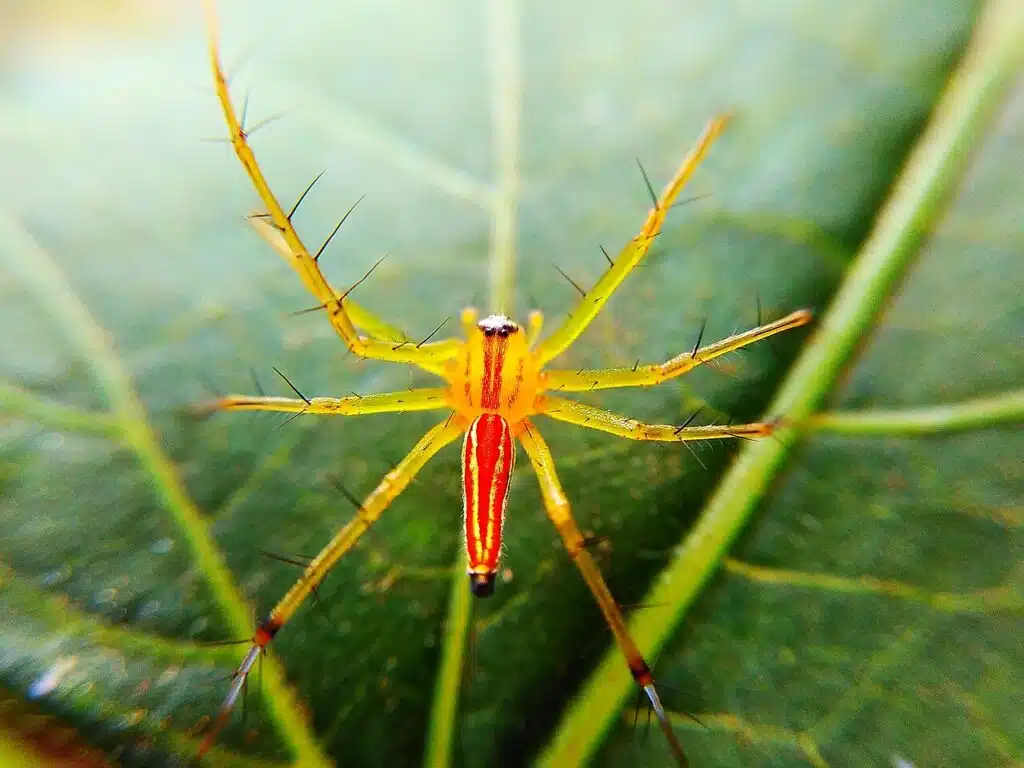
Scientific name: Oxyopes salticus.
Common name: striped lynx spider.
The striped lynx spider was first described in 1845. it can be found in leafy vegetation, weedy fields, row crops, and grasses. Adults vary in color from orange to brown or cream.
The female has stripes on her carapace and abdomen with a diamond mark. Females can grow to 6mm, while males only grow to 5mm in body length. They are common in the Eastern United States from Massachusetts to Texas.
7. Orange Baboon Tarantula
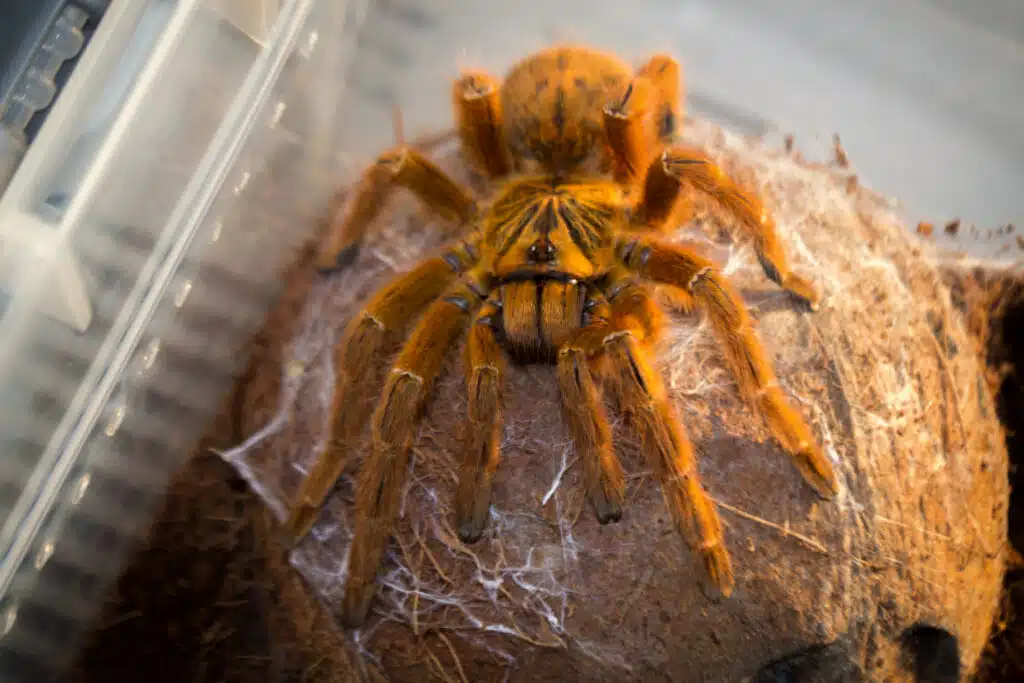
Scientific name: Pterinochilus murinus.
Common name: Orange baboon tarantula, Mombasa golden starburst tarantula.
The orange baboon tarantula was first described in 1897 on the African continent. They are popular as exotic pets for their orange color.
This is a very defensive tarantula, an old-world tarantula that should never be held. Their bites are not considered serious, but they can be exceptionally painful. They are willing to inflict a bite, which is why caution is advised.
The orange baboon tarantula can grow to 15cm in size. Males are smaller at around 10cm. They are the uniform color from their abdomen, carapace to their legs. The legs often have a colored ring pattern.
There is a star-shaped pattern on the abdomen. The body is covered with short hairs and long hairs on the legs. They are burrowing spiders and are not common in pet stores, even though they are very popular in the exotic pet trade.
8. Spotted Orbweaver
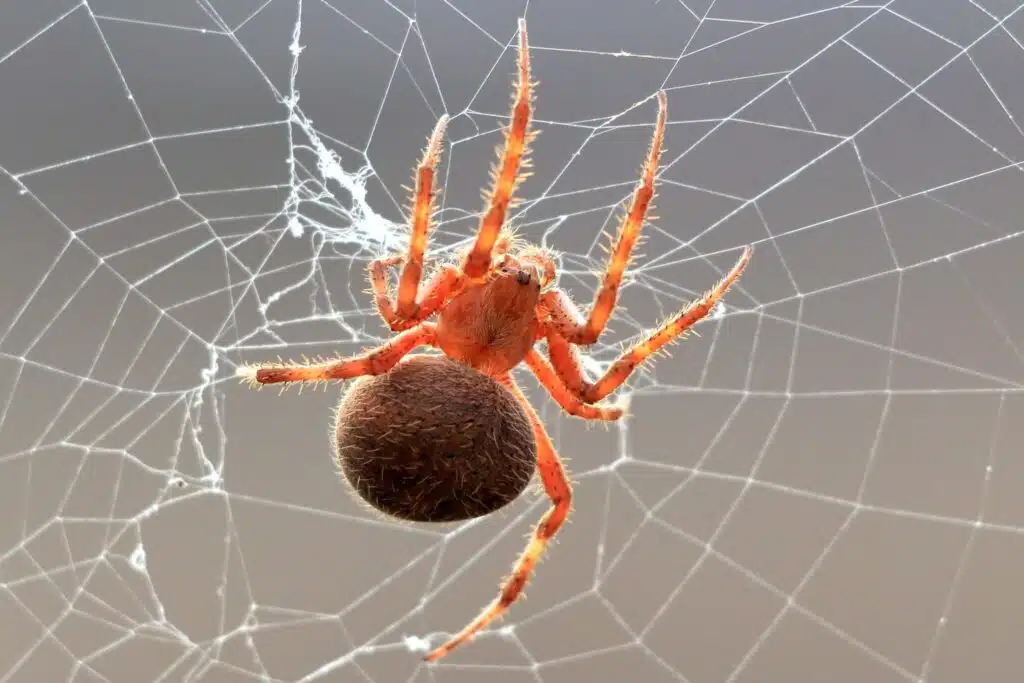
Scientific name: Neoscona crucifera.
Common name: Hentz orbweaver, spotted orbweaver, barn spider.
The spotted orb weaver can build a circular web reaching two feet in diameter. They hide in the day in a curled leaf near their webs. Their color varies from tan to orange or red.
They have bristles on their head, thorax, abdomen, and legs. These spiders can be found in gardens, backyards, fields, and parks. They are nocturnal, so seldom seen during the day.
9. American Nursery Web Spider
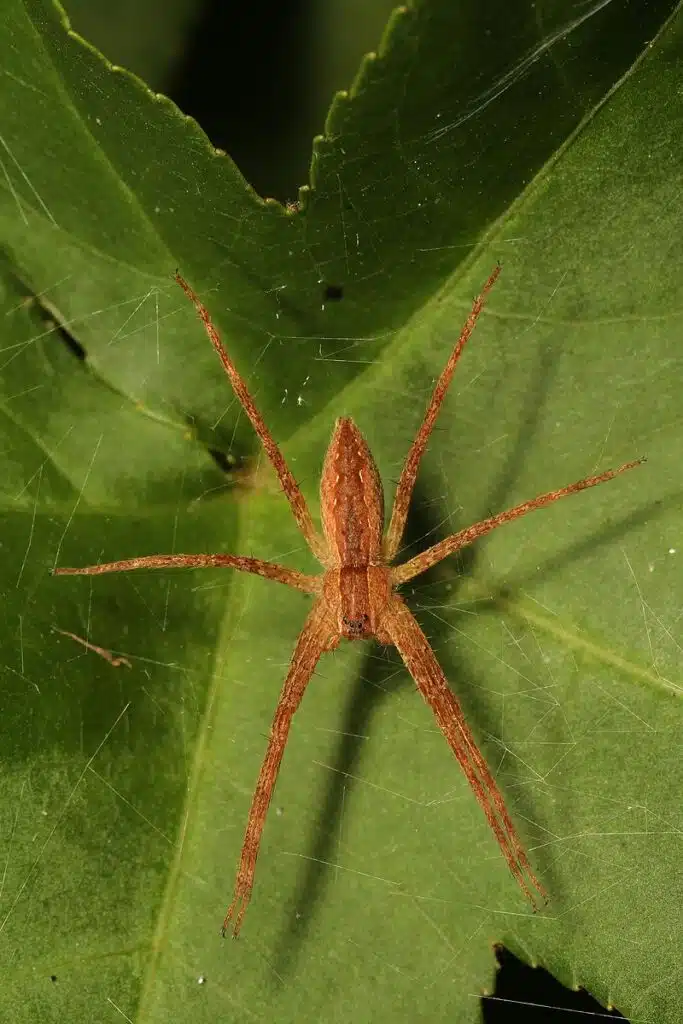
Scientific name: Pisaurina mira.
Common name: American nursery web spider.
The American nursery web spider has a narrow abdomen. The cephalothorax is a hard covering for protection. Their abdomens are bulb-like.
Males and females are similar in size, with females being slightly larger at around 15mm in length. They are a yellow/brown color with a light or dark band down the center of their back. There is a white border on the abdomen.
These large spiders are often confused with wolf spiders. American nursery web spiders are excellent parents that carry their egg sac with care, placing it in a hidden space and protecting it.
10. Arrowhead Orbweaver
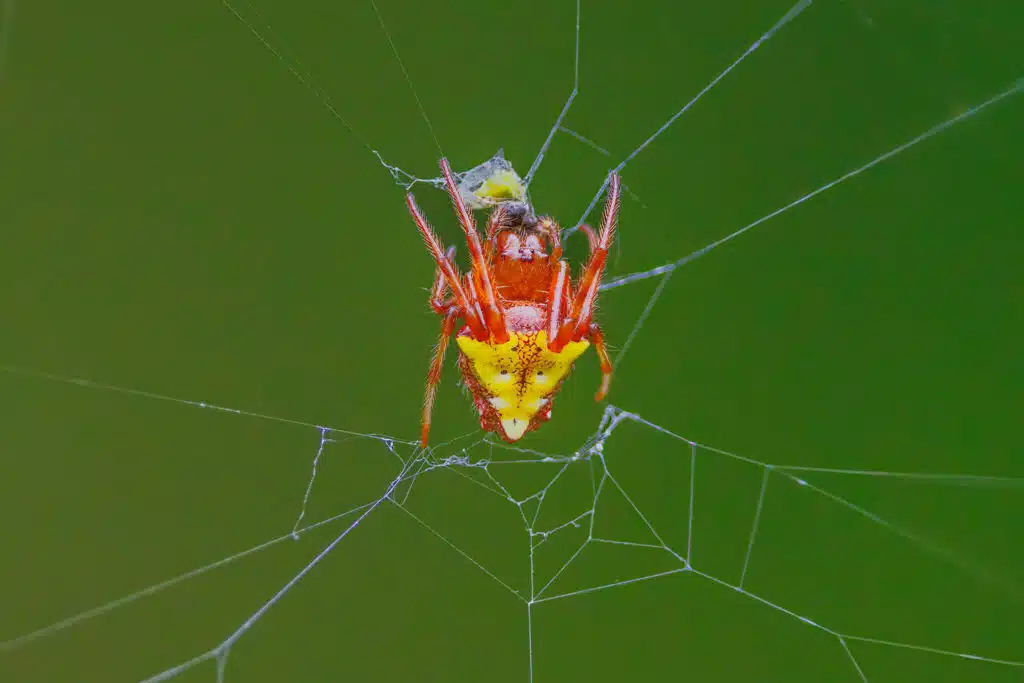
Scientific name: Verrucosa arenata.
Common name: Triangle orb weaver, Arrowhead spider.
The arrowhead orb weaver is common in North America and a well-known and large orb weaver that sits facing upwards in its web. They have a pointed and triangular-shaped abdomen, which is similar to the tip of an arrow.
They can be found in urban and rural habitats where there are plenty of trees and bushes to spin their webs. They are more common in late summer and early fall.
Females can grow to around 14mm in body length with males being half the size. The abdomen color ranges from white to yellow with red markings on the abdomen. Females tend to have brown, black, or rusty orange color on their legs and carapace.
Their abdomens have a yellow or white triangle, which males often lack.
11. Garden Ghost Spider
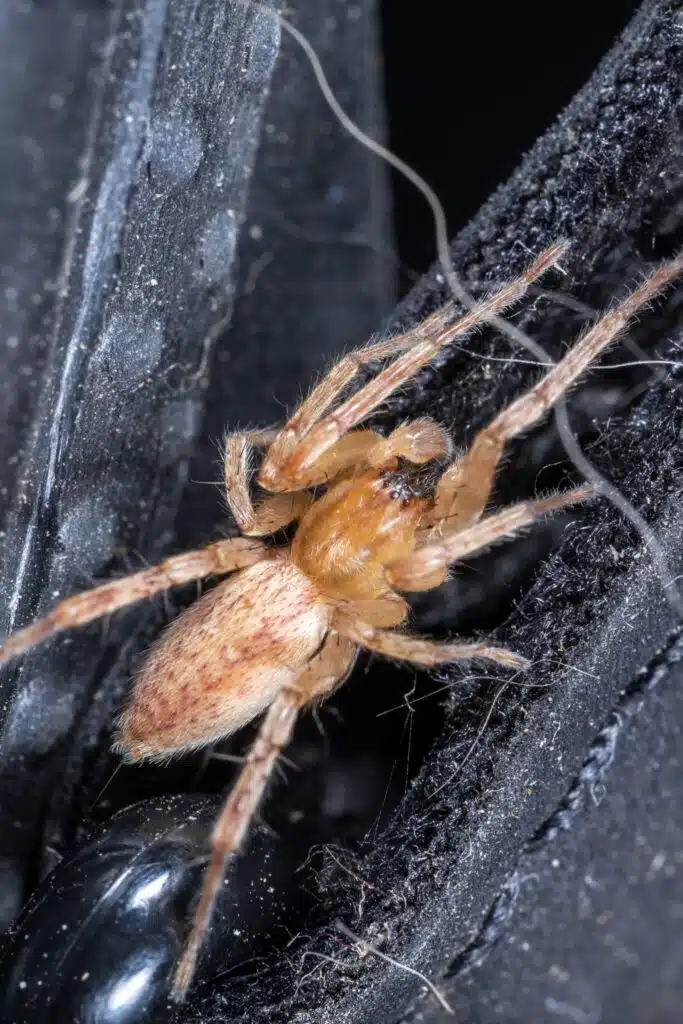
Scientific name: Hibana gracilis.
Common name: Garden ghost spider.
The garden ghost spider can grow to half an inch in size with jaws that move side to side. Their eight eyes are closely grouped with an elongated abdomen. These spiders can be brown and yellow or being green-yellow, some often confused as orange.
They are distributed in North America, especially in Florida. These spiders are active hunters and hide in their retreats during the day. They are not harmful to humans, though their bites can be painful, about as bad as a bee sting.
12. Black-tailed Red Sheetweaver
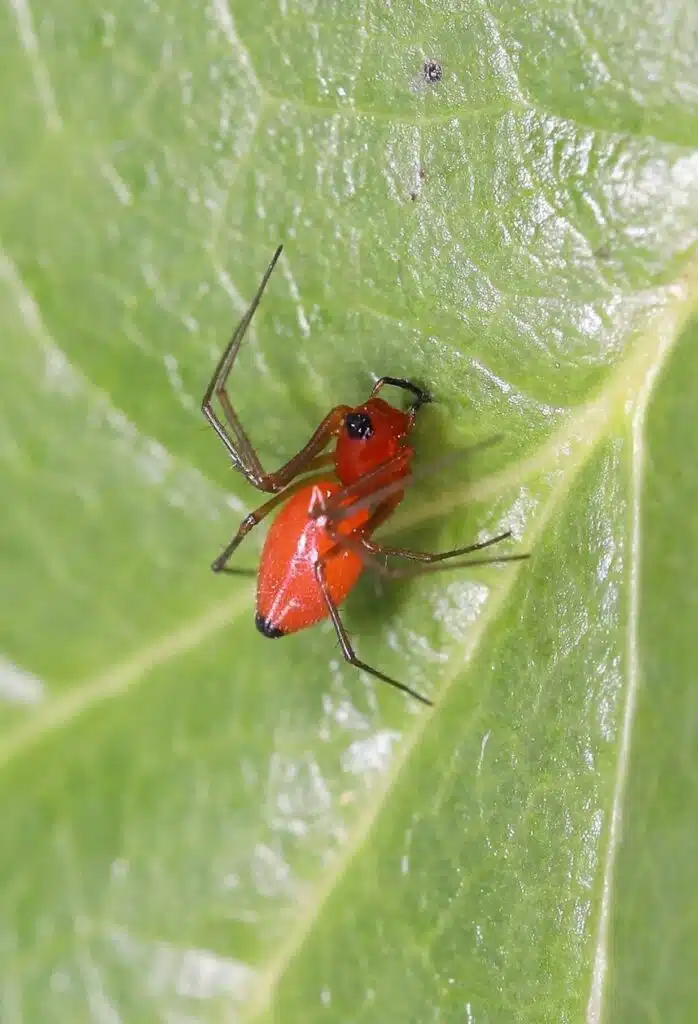
Scientific name: Florinda coccinea.
Common name: Black-tailed Red Sheetweaver.
This spider is also known as the red grass spider and is a dwarf spider, first described in 1896. It is common in the southeastern United States, where it lives in agricultural fields and grasslands.
This red spider is often confused as deep orange, growing to 4mm in length. The female is slightly larger than the male. They create horizontal sheets of webbing, which is not sticky and has a tangle of stopping threads above.
Stopping threads intercept any flying prey, causing them to fall into the sheet below, which is when the spider strikes.
13. Whitman’s Jumping Spider
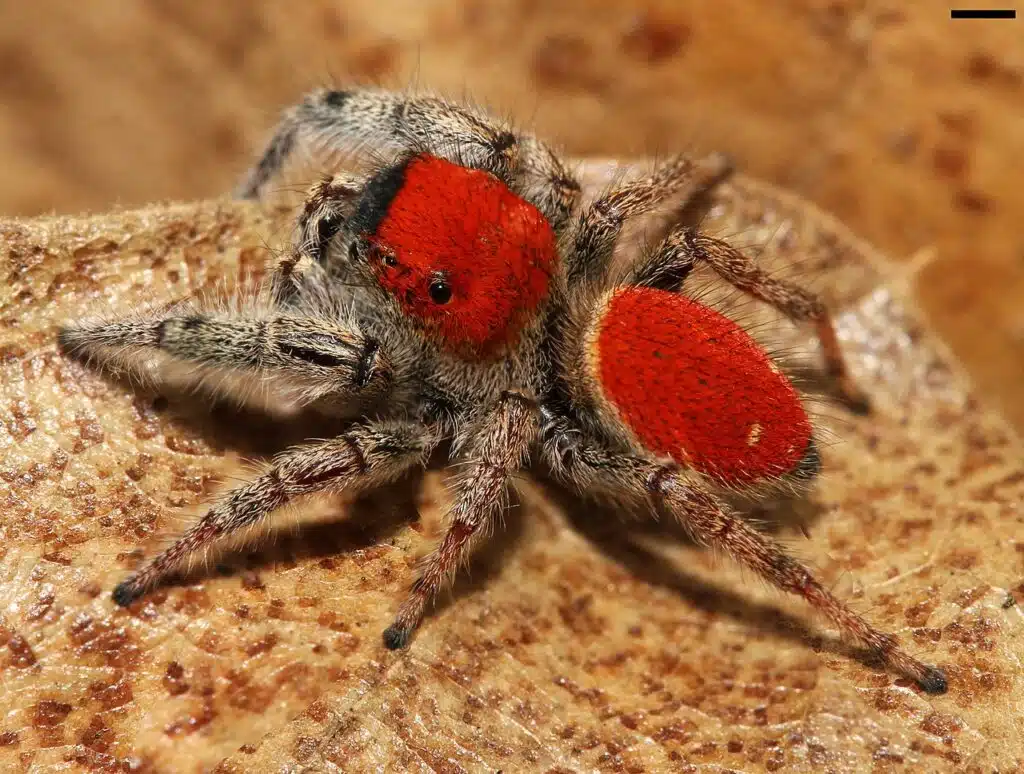
Scientific name: Phidippus whitmani.
Common name: Whitman’s Jumping Spider.
Jumping spiders are harmless and interesting spiders. The Whiteman’s jumping spider is red on top with black banding on the frontal eye region. Females are brown, while males are brightly colored.
These spiders mimic the mutillid wasp and are distributed throughout the United States.
14. Cardinal Jumping Spider
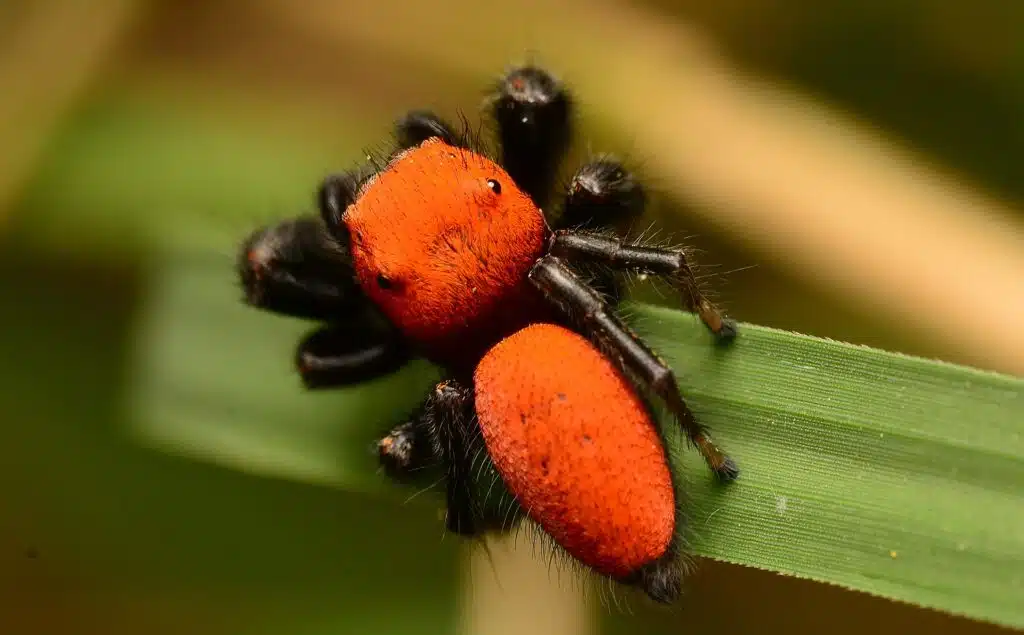
Scientific name: Phidippus cardinalis.
Common name: Cardinal jumping spider.
Cardinal jumping spiders are small spiders with the female being larger than the male. They have a red carapace, black bands on the dorsal abdomen, and hairy black legs. The red is often confused with orange.
The carapace is oval and they do not spin webs to capture their prey. These spiders can jump more than four times their body length from standing, using it to ambush prey and escape predators.
The cardinal jumping spider is completely harmless to humans, seldom biting and using fleeing as their main form of escape.
15. Gem-shaped Orbweaver
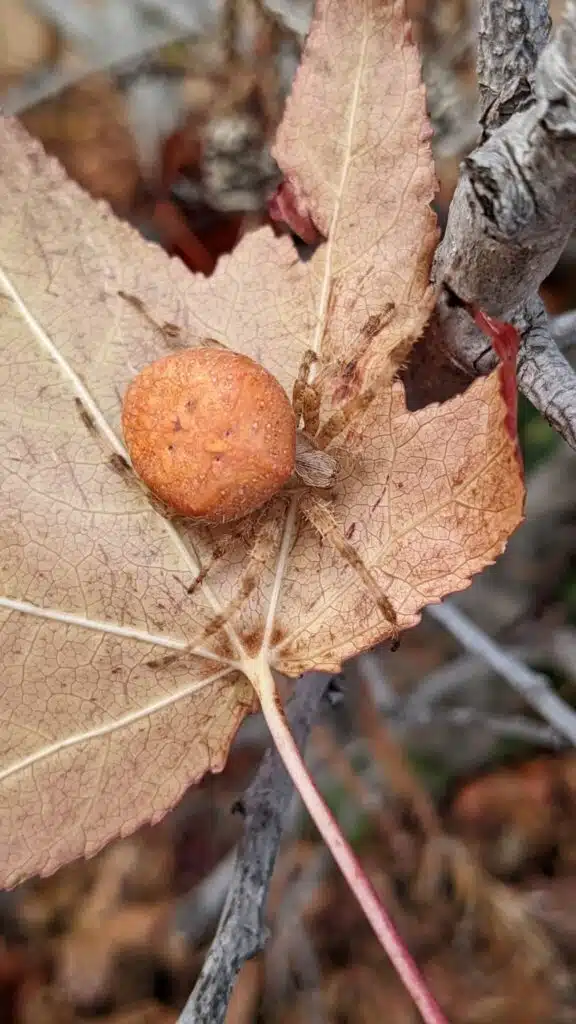
Scientific name: Araneus gemma.
Common name: cat-faced spider.
Gem-shaped orb weavers are also known as jewel spiders or cat-faced spiders. They are common outdoor spiders in the United States and are completely harmless to humans.
Their webs are often located near lights, on the side of buildings, and in closed spaces. They can also be seen under overhangs and wood. Their colors are varied, some often looking a light orange color. They have two horn shapes on their abdomen.
These spiders tend to change their coloration from summer to winter.
16. Apache Jumping Spider
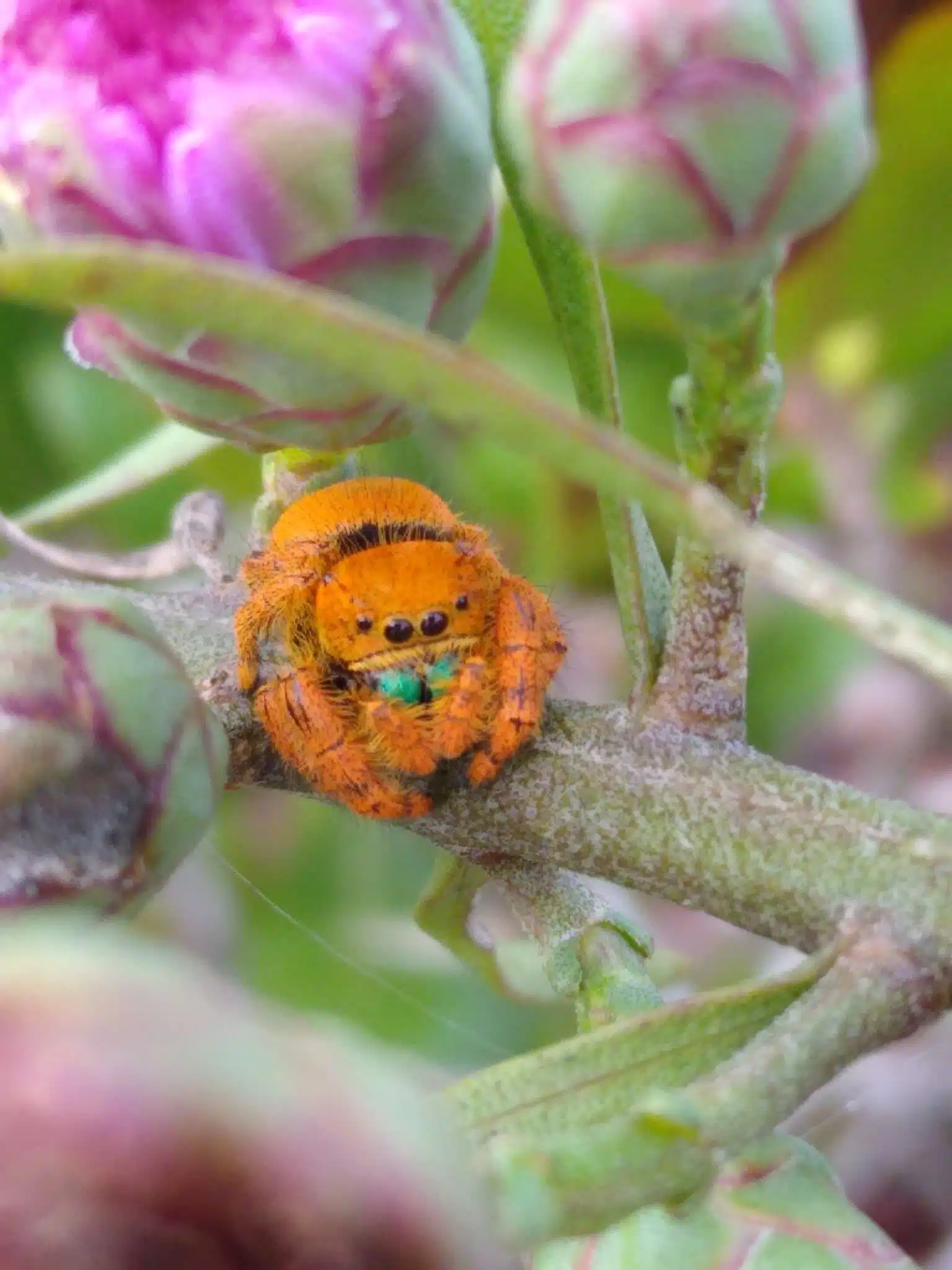
Scientific name: Phidippus apacheanus.
Common name: Apache Jumping Spider.
The apache jumping spider can be found in the southwestern United States and is common in Utah and Nebraska, Texas, and Arizona. These spiders prefer fields, deserts, and dry grasslands, often seen on shrubs and vegetation in dry areas.
These spiders are large jumping spiders that can grow to 22mm in large gravid females. They have incandescent green chelicerae. Females are black with orange on their cephalothorax and abdomen. There is often a black stripe on the abdomen.
Dorsal coloration is yellow, orange, or red, while they have a black underside. Males are more of a red/orange color.
17. Black-banded Crab Spider
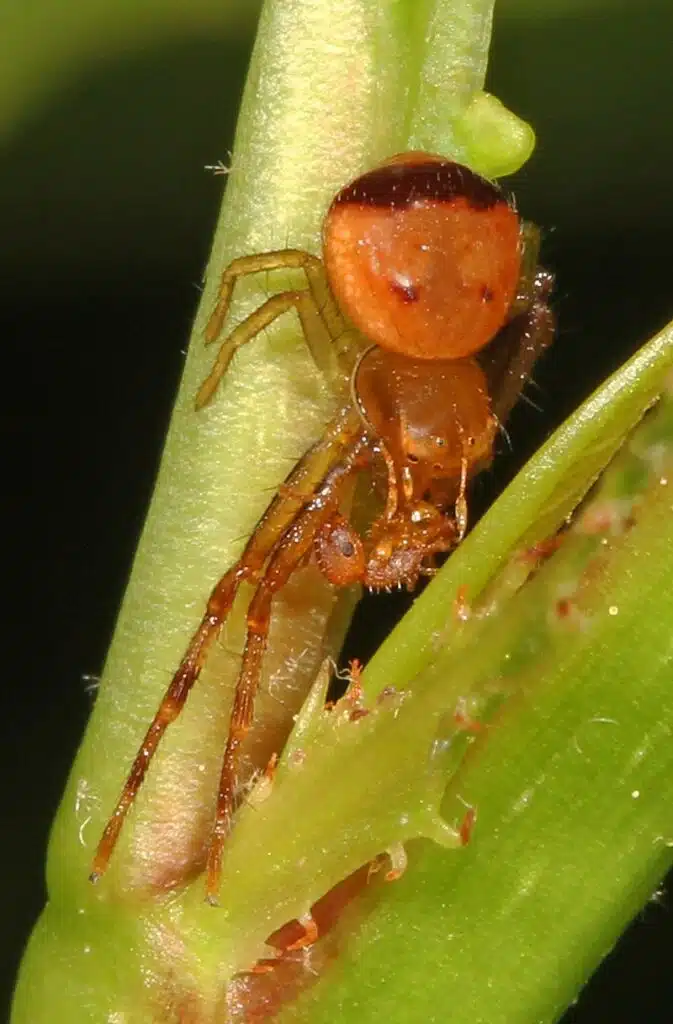
Scientific name: Synema parvulum.
Common name: Black-banded Crab Spider.
The black-banded crab spider has longer front legs than other spiders. Their back legs are shorter, which gives them the appearance of a crab. They are also able to walk forwards, sideways, and backward.
This crab spider is a small red/brown spider with a wide and round abdomen. The abdomen has a black crescent shape, making the spider look as though it was dipped in black ink.
These are ambush spiders, lying in wait on flowers and capturing pollinating insects, often much larger than themselves. They are not known to bite humans.
18. Orange Ant-mimic Sac Spider
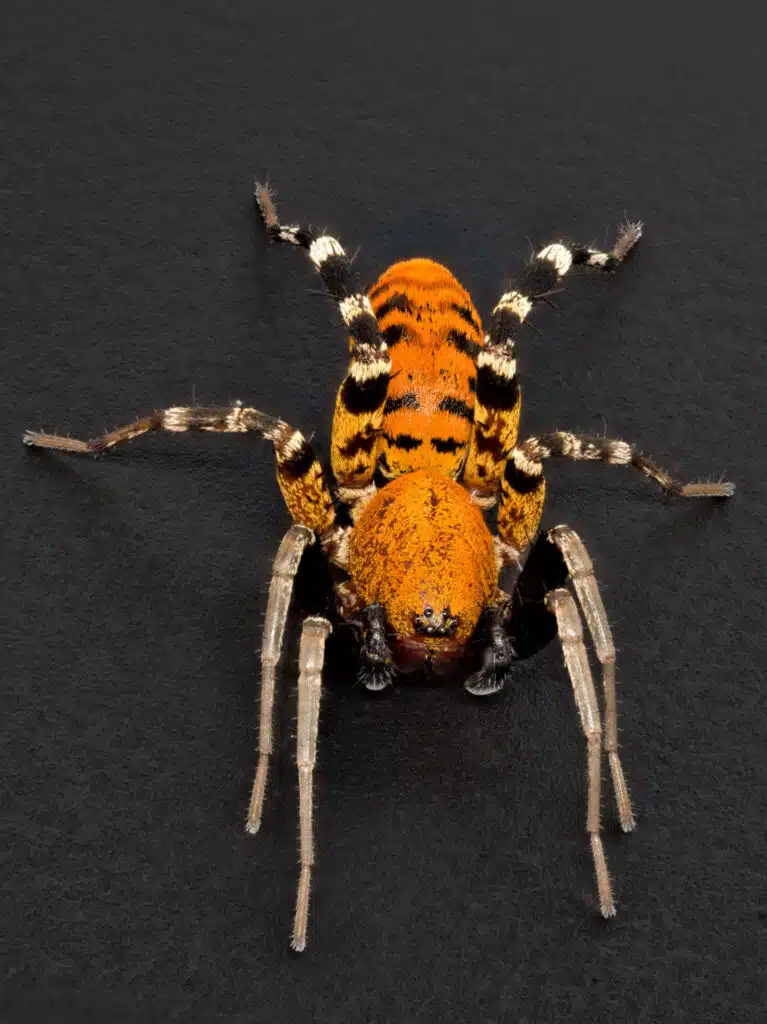
Scientific name: Castianeira amoena.
Common name: Orange Ant-mimic Sac Spider.
The orange ant mimic sac spider was first described in 1879 and is native to North America. These spiders have eight eyes with an elongated or oval-shaped opisthosoma.
They are small and fast spiders with similar coloration to ants. They blend in with their food source. They are known to rub their front pair of legs together, raising them up in the air to look like ant antennae.
Their resemblance to ants, could also be a defense mechanism with ants tasting awful to mammals, insects, and birds. Females are slightly large than males, living on smaller insects.
They can be found where you would find ants, in gardens, woods, under stones, and in fields.
19. Spinybacked Orbweaver

Scientific name: Gasteracantha cancriformis
Common name: Spinybacked Orbweaver
Often found in North America, Spinybacked Orbweavers are spiders known for being primarily white, with small black dots, and colorful red spines.
Other morphs or specimens are also known, and found in The United States.
For example, there’s an orange Spinybacked Orbweaver, dominated by an orange background color, with the same small black dots and the black spines the species is known for.
This is also a spider specimen with tiny orange dots visible on its almost completely black ventral side.
Its orange morph has plenty of sightings around the Southern US states as well as around Central America.
Spinybacked Orbweavers often eat different types of bugs and insects that affect crops. They are rarely removed from gardens, as a result.
Even more, these spiny-looking spiders have also been introduced in some areas for their beneficial ecosystem role.
20. Golden Silk Spider
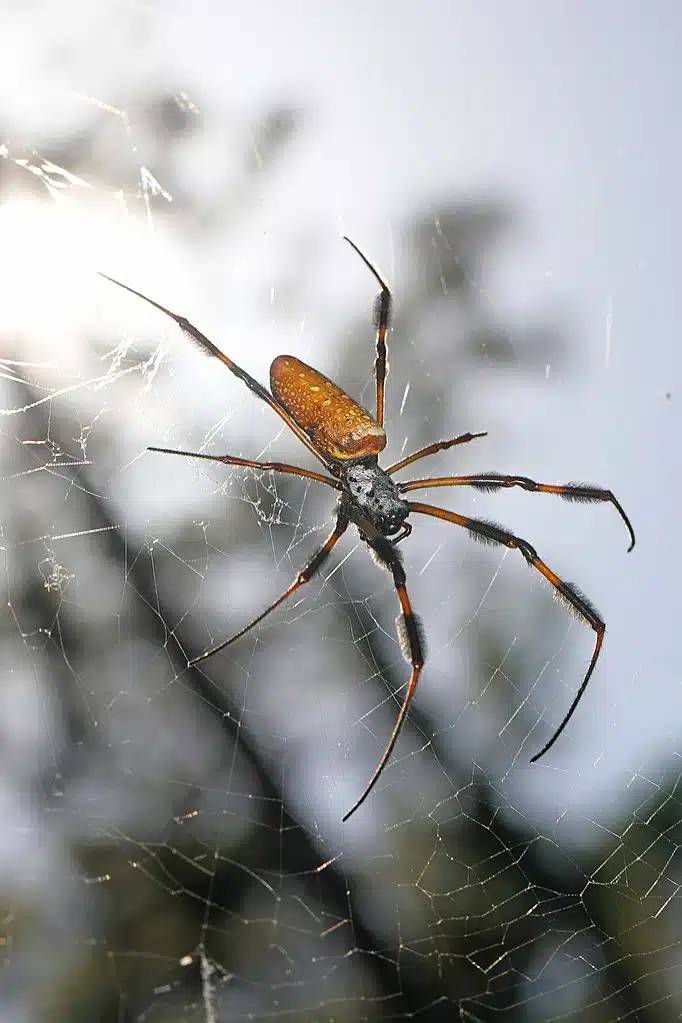
Scientific name: Trichonephila clavipes
Common name: Golden Silk Spider
Also a species of The Southern US, much like the orange specimen Spinybacked Orbweavers, these types of spiders are also partly orange.
Orange and dark brown nuances are specific to this spider genus. They show very long orange and brown legs and a smaller dark brown body.
They are known for building large spider webs which can trap small insects, including bees.
The size of the spider might even seem problematic as the species can appear dangerous, growing to more than 2 inches (including legs).
Golden Silk Spiders rarely bite. They’re also considerably less dangerous compared to other species and their bite is believed to have reduced pain.
Golden Silk Spiders are some of the most common types of spiders in The Americas. They are found in a vast area from Southern US, Central America, and South America.
The species also shows constant and growing numbers in multiple states of Southeast Asia.
21. Spined Micrathena
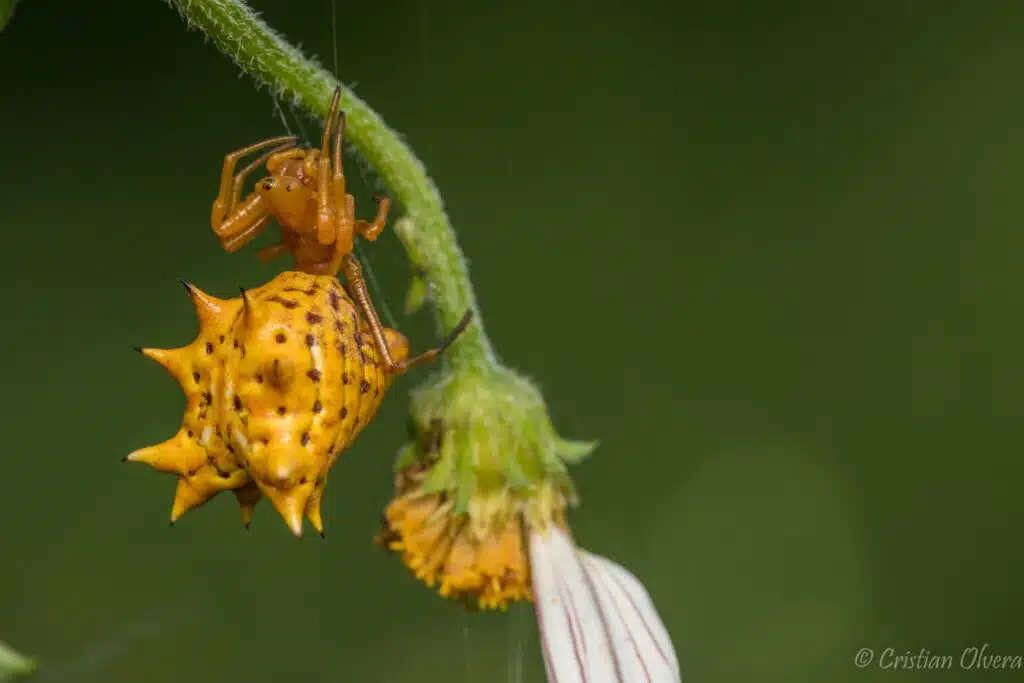
Scientific name: Micrathena gracilis
Common name: Spined Micrathena, Castleback Orbweaver
A species known for building large spider webs which are repaired at night, Spined Micrathenas also come in different colors.
Its orange species is particularly common in the Southern parts of its range.
This is a species found along the Eastern US coast, as well as throughout Central America.
Its orange morph is mostly spotted in the Southern limit of its range.
Bright and dark orange nuances are seen along its body and legs. This is a species that additionally showcases orange spines of various shapes and sizes.
While its spines are also orange, the spine tips are black or dark brown. Its cephalothorax is also mostly dark brown.
22. Six-spotted Orbweaver
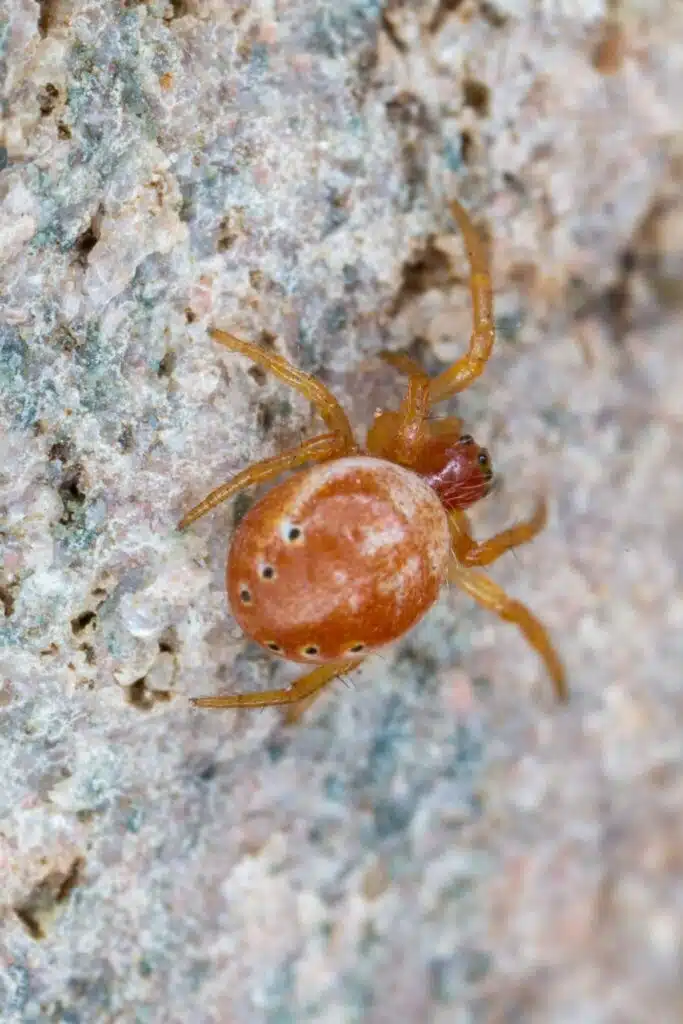
Scientific name: Araniella displicata
Common name: Six-spotted Orbweaver
Six-spotted Orbweavers come in different colors, from green to orange. All of the colors they are known for are contrasted by tiny black dots on the abdomen.
These 6 black dots are also seen on the orange morph of the species. Females are known for often taking an orange nuance, together with the juveniles.
The female can have a large green abdomen with orange stripes and an orange-brown cephalothorax.
Juvenile Six-spotted Orbweavers are typically dominated by orange nuances, including on the abdomen which is rarely mostly orange in adults.
This is a species with orange-brown legs in its juveniles as well.
Females are seen laying their eggs sac as well as building their spider webs. They prefer to use one or multiple leaves as anchoring points for their spider webs.
23. Regal Jumping Spider
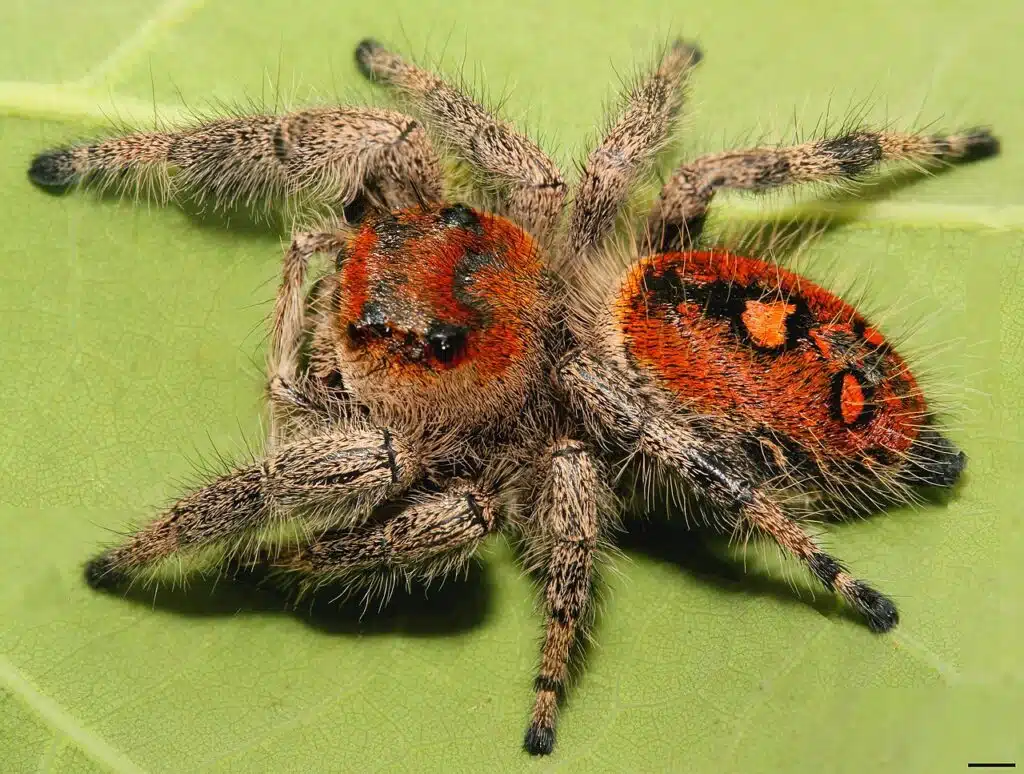
Scientific name: Phidippus regius
Common name: Regal Jumper
There’s a clear coloring difference between male and female Regla Jumping Spiders. This is a species where males are dark while females are bright.
Regal Jumping Spiders are mostly black when male. The female has an orange ground color, both on the cephalothorax and on the abdomen.
This orange female is dominant across the range, with an emphasis on its Florida populations.
Darker orange nuances are specific to females. These are closer to brown and contrasted by black patterns across the dorsum.
Gray and black sections are further specific to the orange female across the legs, similarly to the legs of the male.
As males, females can also jump. They use jumping techniques to ambush prey such as small insects.
24. Versicolor Long-jawed Orbweaver
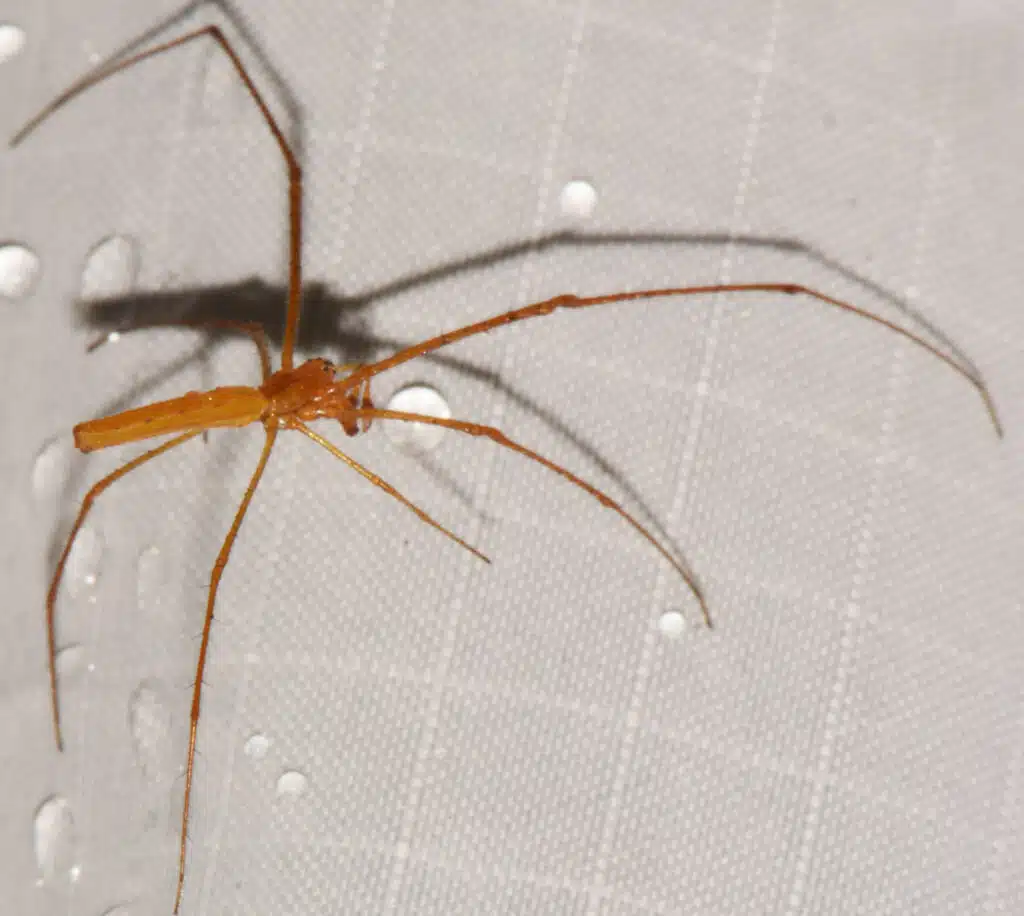
Scientific name: Tetragnatha versicolor
Common name: Veriscolor Long-jawed Orbweaver
A tiny spider with very long legs compared to its body size, Veriscolor Long-jawed Orbweavers are among the orange spiders of The West Coast, with an additional presence in Northeastern North America.
This is a species which is also found in Alaska.
Yet, many orange Veriscolor Long-jawed Oweavers are found in California’s forests.
Yellow and orange specimens are the most common in The Veriscolor Long-Jawed Orbweaver.
While its long jaws are normally orange-brown, this is still a species that has mostly orange legs and a pale orange body.
Both the yellow and the orange specimens are further known for their short spiny black hairs covering their legs.
Females, building webs, are typically spotted resting right in the center of their spider web.
25. Desert Red Jumping Spider
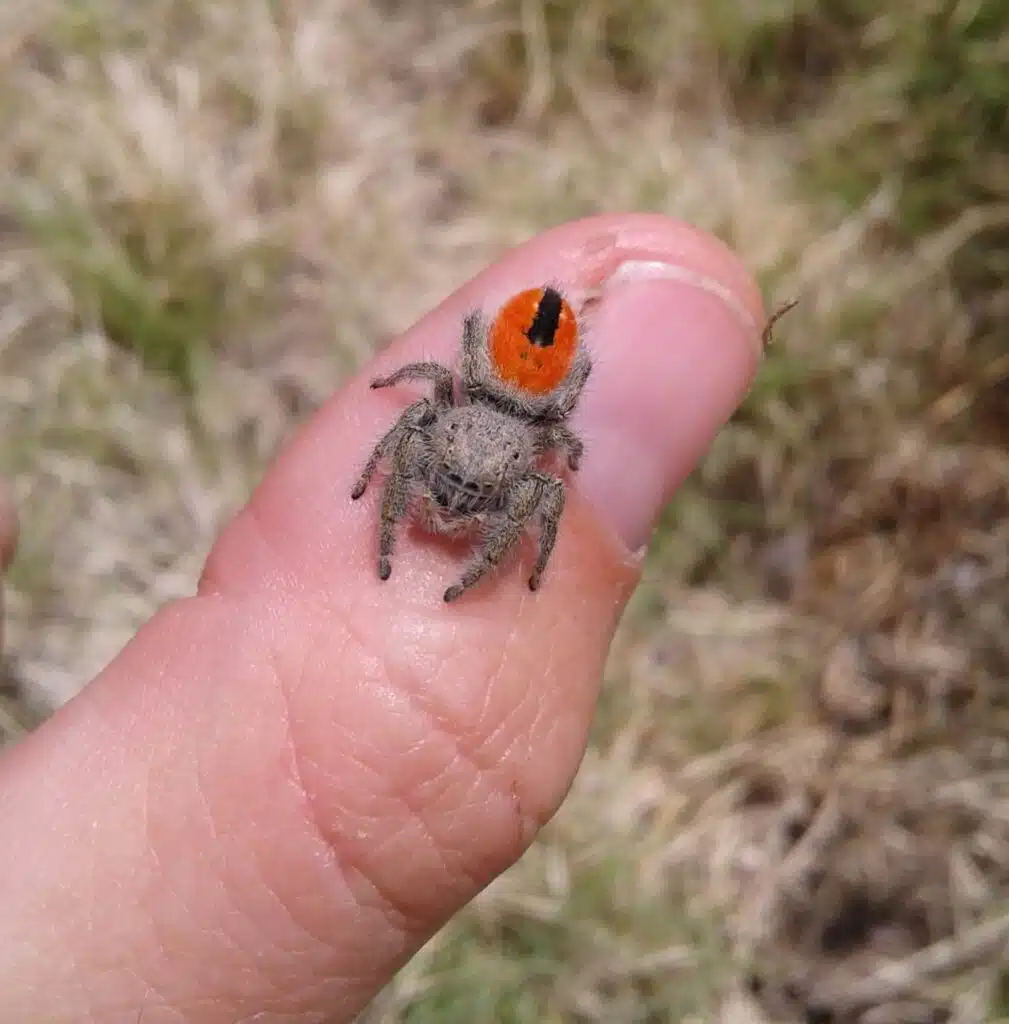
Scientific name: Phidippus ardens
Common name: Desert Red
A species of the Southern US and Mexico, Desert Red Jumping Spiders are mostly known for their red abdomens.
However, there’s also an orange specimen which is also highly common in the Southern deserts.
This is a specimen with a mostly orange abdomen that features a white pattern in the center of the abdomen.
Red abdomen morphs and yellow abdomen morphs both show different types of colored abdomens with black spots in the center.
Even more, the orange morph of this species also shows a distinct white band or white margins around the abdomen, a physical trait not seen in the other morphs of the species.
If males are orange and black, females and some juveniles are orange and gray, or even orange and white.
26. Spintharus flavidus
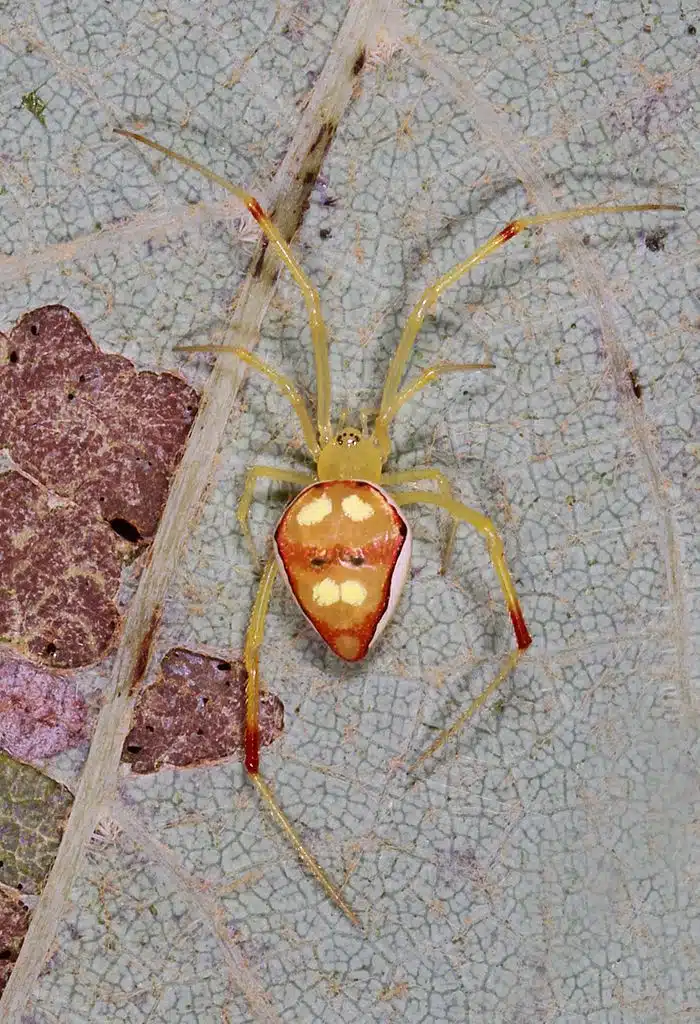
Also found in The United States but mostly in Cuba, Ecuador, and The Dominican Republic, this is a spider species that comes in orange nuances.
Its abdomen is the only true orange section of its body. It features 2 large pale orange spots plus dark orange margins.
A central darker orange stripe separates the bright orange sections of the abdomen. Additional bright yellow spots decorate its abdomen.
The legs and the cephalothorax of the species bear a bright yellow nuance.
Yellow and orange nuances are also spotted along its legs.
27. Openfield Orbweaver
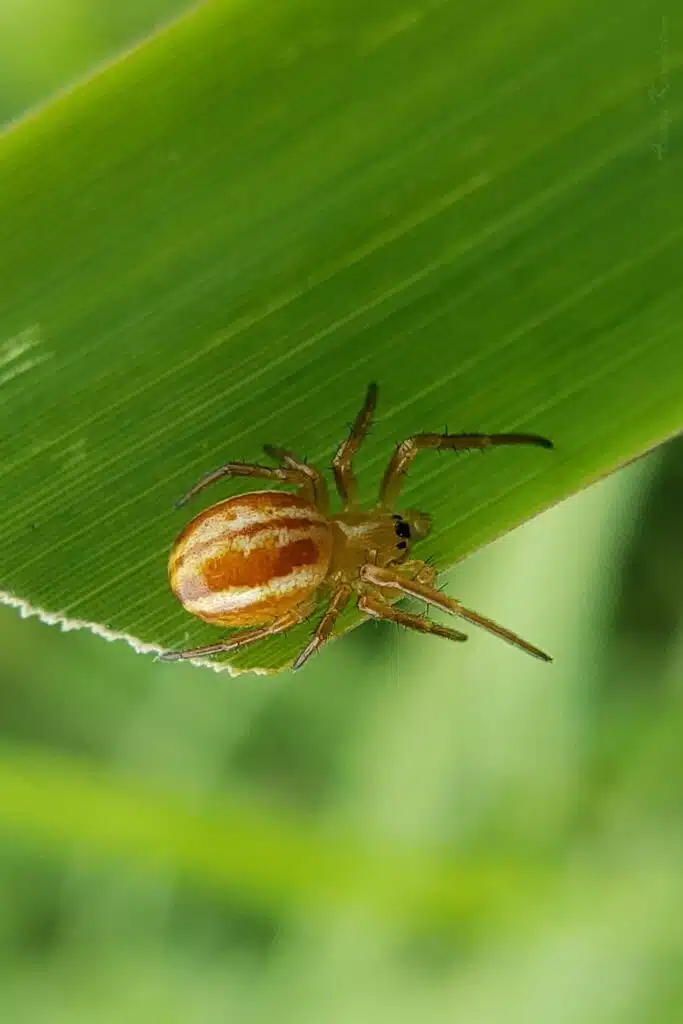
Scientific name: Araneus pratensis
Common name: Openfield Orweaver, Orange Orbweaver, Brown Orbweaver
As a small orbweaver, The Openfield Orbweaver is a species that grows to an average of 0.2 inches, with females being slightly smaller.
Despite its reduced size, The Openfield Orbweaver is a species that has either bright brown or orange nuances.
This is also a species with orange-brown nuances when it comes to the stripes on its abdomen.
Orange and white stripes are the most common on its abdomen. These vertical stripes help the species stand out whole its cephalothorax and legs are bright orange.
The nuance of its legs and cephalothorax can appear brighter due to the slightly translucent appearance of the species.
Spotting this species might not be as easy as it may be resting during the day and only active at night.
28. Big-eyed Thick-jawed Spider

Scientific name: Pachygnatha autumnalis
Common name: Big-eyed Thick-jawed Spider
A species of the Southern US and Cuba, Big-eyed Thick-jawed Spiders have a unique appearance.
They feature a bulbous abdomen and an elongated thorax plus very long legs in relation to the size of their body.
Bright orange, dark orange, and additional black and white nuances are specific to the spider.
This species has vivid orange abdomens with a bright orange central stripe. The sides of the abdomen are mostly white with a black border towards the orange sections.
Its cephalothorax is dark brown with brighter brown legs.
Small and often only reaching a size of 1 inch together with its legs, this is a type of orange spider that also features other common morphs.
It additionally comes in a black abdomen morph. All other morphs feature different abdomen coloring while the cephalothorax and legs remain brown.
29. Horned Parasitic Cobweaver
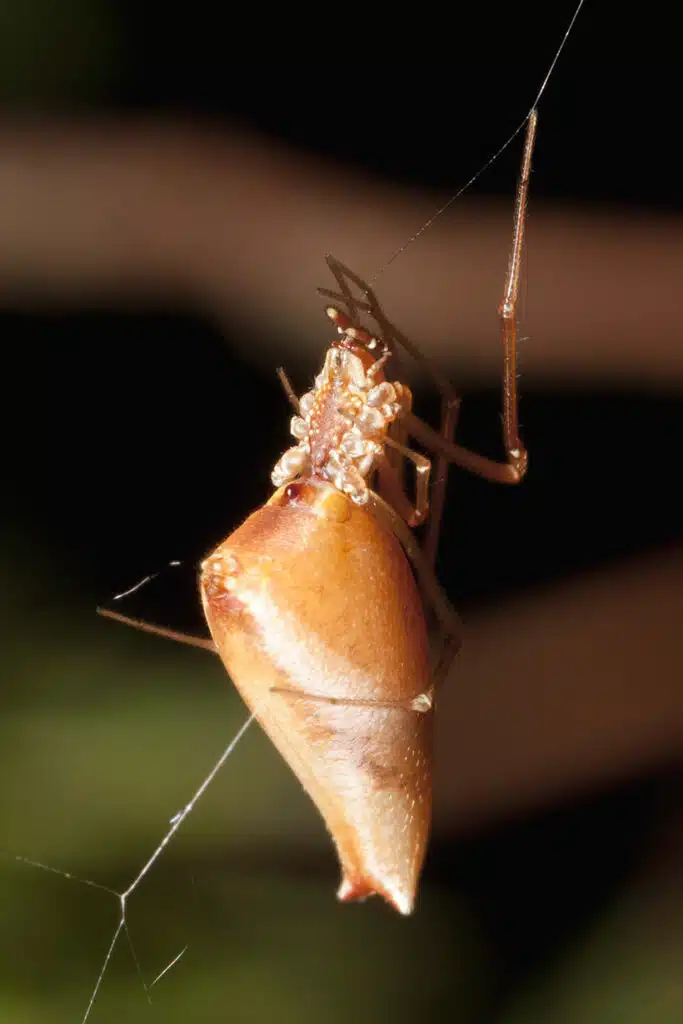
Scientific name: Neospintharus trigonum
Common name: Horned Parasitic Cobweaver
Female Horned Parasitic Cobweavers have an orange appearance. This is a spider species that has different colors and even various morphs, such as the green morph.
While males are darker, females are mostly orange.
Brighter and darker nuances are specific to the female.
Its bulbous abdomen is mostly bright orange, with a mid-dorsal darker orange stripe.
Darker orange nuance is a further characteristic of its cephalothorax. This is a species with long dark orange legs as well.
Some variants with orange are also specific to Horned Parasitic Cobweavers. These spiders are often seen in a dark brown morph. This is a morph that also shows additional orange sections, particularly around the sides of the thorax and the abdomen.
Are Orange Spiders Poisonous?
It’s not uncommon to see orange spiders or what looks like an orange spider in North America. The good news is that they are not considered dangerous to humans. Most will give a painful bite but are not considered medically significant.
The only orange spider of concern is the brown widow, with an orange hourglass shape on the belly. This spider may not be as poisonous as the black widow, but they still give a painful bite, with redness and swelling, which is limited to the bite area.
Summary
There are a number of spiders that are orange, have orange on them or look orange, due to their red/brown or yellow/brown coloration. The spiders listed mostly live outdoors but can be encountered in back yards and inside homes from time to time.
Being able to identify an orange spider will help you know if you should be concerned and the safest way to remove it from the home.
Further Reading: